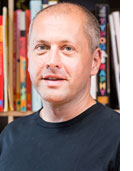—-
To stay in the loop with the latest features, news and interviews from the creative community around licensing, sign up to our weekly newsletter here

Skew’s Oliver Dyer, Licensing Link’s Chris Taday and The Ashmolean Museum’s Declan McCarthy tell us which iconic figures deserve brand extensions of their own.
This year, we have seen a raft of creative products and experiences launched around iconic historical figures.
Back in July, KITH teamed with House of Mandela for a Mandela Day apparel collection. KITH’s design team worked directly with Nelson Mandela’s daughter Makaziwe Mandela and his granddaughter Tukwini Mandela to create the range.

Outside of apparel, House of Mandela – the organisation through which the descendants of Nelson Mandela preserve the legacy of the family name – has also launched successful brand extensions in wine and jewellery in recent years.

It’s also been a busy year for the Van Gogh Museum thanks to a number of striking brand collaborations. A range of toys launched last month with Playmobil, while the Museum also teamed up with Floral Street on a line of fragrances inspired by Van Gogh’s work.

This year also saw Van Gogh: The Immersive Experience land in London. This digital art experience showcases Van Gogh’s work through 360-degree digital projections and unique VR experiences that take visitors inside some of his most iconic paintings.

Moving across to advertising, the likeness for Albert Einstein has been licensed by Smart Energy GB to front its ‘Join the energy revolution’ campaign which encourages mass installation of smart meters.
“There is no greater ambassador for modern technology than Albert Einstein,” said Chris Taggart, director of marketing at Smart Energy GB, adding: “We hope the public really enjoy seeing his wit and humour touchingly brought back for this campaign.”
To find out what other iconic figures from history deserve brand extensions of their own, we spoke with Skew’s Oliver Dyer, Licensing Link’s Chris Taday and The Ashmolean Museum’s Declan McCarthy.
 Oliver Dyer, MD, Skew
Oliver Dyer, MD, Skew
Our pick is the American aviation pioneer, Amelia Earhart.
When Skew begins work on a brand extension with a new IP, we begin by auditing the visual and intangible assets of a brand to map what transfers well. Amelia Earhart’s inspirational life story has everything you could need, plus the cultural zeitgeist of the times is ripe for a real-life action hero.
Visually you have Amelia herself. Effortlessly cool, nonchalantly styled and with timeless grace. Surely one of the inspirations behind the female leads in Apple TV’s For All Mankind.
There’s also the wealth of imagery associated with 1920s and 30s Americana – and that’s before you even start to tap the romantic period imagery associated with aviation at the time.
The immense achievement of being the first solo female to cross the Atlantic has left a legacy of inspiration for everyone. But it’s surely women and girls that deserve to take ownership of her as their hero and a counter to the billionaire bro’s flying their phallic symbols into the stratosphere.
Scotch and Soda has a line out ‘inspired by’ her but she deserves to be font and centre. Her life and times have all the qualities a heritage and lifestyle brand needs to cut through the mass market.
Need more? I leave it to her own words. Sixty years before Nike’s “Just Do It’, Amelia gives us this: “The most effective way to do it, is to do it.”
Amelia Earhart. She deserves a multi category, multi territory approach and we’d love to see it happen.

 Declan McCarthy, Head of Publishing and Licensing, The Ashmolean Museum
Declan McCarthy, Head of Publishing and Licensing, The Ashmolean Museum
I have been mulling over possible historical figures that have licensing potential. I thought Stradivari might be a fine example of a great craftsman, whose efforts and creations since the late 17th/early 18th century continue to engage, captivate and astound to this day.
Antonio Stradivari was born in Cremona in 1644. Much of his early life is shrouded in mystery but we know that he made his first (known) violin in 1666. In any assessment of Stradivari’s enormous contribution to our civilisation, it’s important to bear in mind the extraordinary length of his working life as well as the strength of his character.
 A study of the development of the style and technical characteristics of the instruments that came from his workshop during the period of 70 years that passed between his first and last instruments leaves little doubt that he must have been almost constantly in his workshop. We can easily imagine that he remained active until the last days of his life, which ended on December 18th 1737, aged 93. More than 1,200 violins are believed to have been made by Stradivari, with at least 600 still surviving after almost 300 years or more. The instruments themselves are revered, often copied and sometime believed to be full of mystique and intrigue.
A study of the development of the style and technical characteristics of the instruments that came from his workshop during the period of 70 years that passed between his first and last instruments leaves little doubt that he must have been almost constantly in his workshop. We can easily imagine that he remained active until the last days of his life, which ended on December 18th 1737, aged 93. More than 1,200 violins are believed to have been made by Stradivari, with at least 600 still surviving after almost 300 years or more. The instruments themselves are revered, often copied and sometime believed to be full of mystique and intrigue.
When people pay money to attend a violin concert, it is not to hear the sound of a violin. It is to hear music that moves them. For the last two centuries, an overwhelming majority of the world’s greatest violinists have determined that it is the instruments of Antonio Stradivari that give them the ability to express the beauty and passion of music.
When the conditions are right, and a great Stradivari violin, viola or cello is played, something very, very special happens. From the player’s perspective, the options for musical expression multiply exponentially. It is as if the tonal world goes from black and white to colour.
And the way a great Strad projects in a great concert hall is truly magical. Not only can one soar over or punch through the texture of an entire orchestra, but one can create a sound that is heard as a whisper from the front to the back of the hall. These instruments create a sound that goes out to the audience, or can be a sound that draws them in.
The name Stradivari is universally known and is synonymous with quality. The Ashmolean is very proud to house the very finest violin made by Stradivari, ‘The Messiah’. Built in 1716, during Stradivari’s ‘Golden Period’ when he was at the peak of his profession, is almost untouched and free from wear and tear, and owes its condition to the fact that it has always been a collectors’ instrument. If it were available (and it isn’t) it would easily be the single most expensive violin in the world.
 Chris Taday, Co-Founder, Licensing Link
Chris Taday, Co-Founder, Licensing Link
The Vincent van Gogh Playmobile figure is such a fun and different way to bring history to life. It offers the opportunity to learn a little about the life of the artist via a toy.
There must always be new ways of telling history to make it both fun and accessible. In the musical theatre, we have learned about America’s Founding Father – Alexandra Hamilton – via its Lin-Manuel Miranda’s Hamilton. Elsewhere, the TikTok generation is learning something about Henry VIII and his six wives via the musical Six, with their story told at a pop concert performed during the show.
 But who else could we turn to in history, develop some historical-based product? Maybe, Leonardo da Vinci, primarily regarded as an artist with his iconic paintings of the Mona Lisa and Last Supper.
But who else could we turn to in history, develop some historical-based product? Maybe, Leonardo da Vinci, primarily regarded as an artist with his iconic paintings of the Mona Lisa and Last Supper.
Throughout his life, he demonstrated a superior intellect, with curiosity for many aspects of life and the world around him. He studied geology, nature, anatomy, flight, gravity, and optics. Hundreds of years before either the materials or manufacturing capabilities were around, he invented the bicycle, the helicopter and the parachute, as seen through the numerous pages of his notebooks, journals, and sketches.
In terms of product development, let’s take these blueprints and build a model collection of his ground-breaking designs that looks to inspire a curiosity in design. Include da Vinci-style journals with the collection to inspire the model builders to create their future designs. Or even the templates for 3D printing of the plans – what would need to change to make them fully functional vehicles?
We need to spark a curiosity for the world around us – and Leonardo da Vinci would be a tremendous role model.
Enter your details to receive Brands Untapped updates & news.